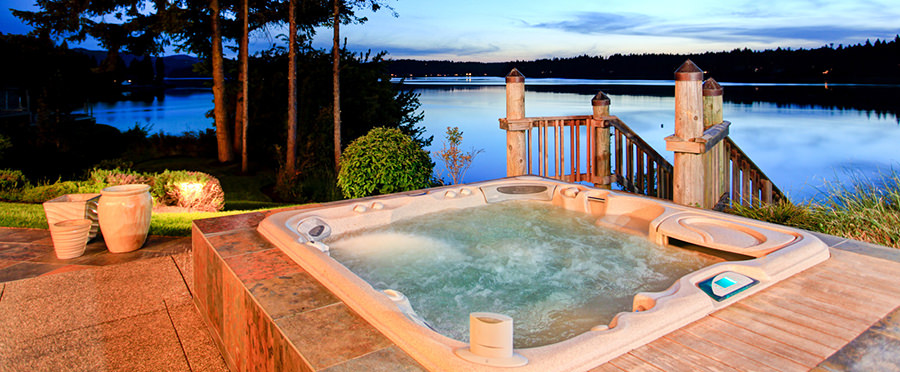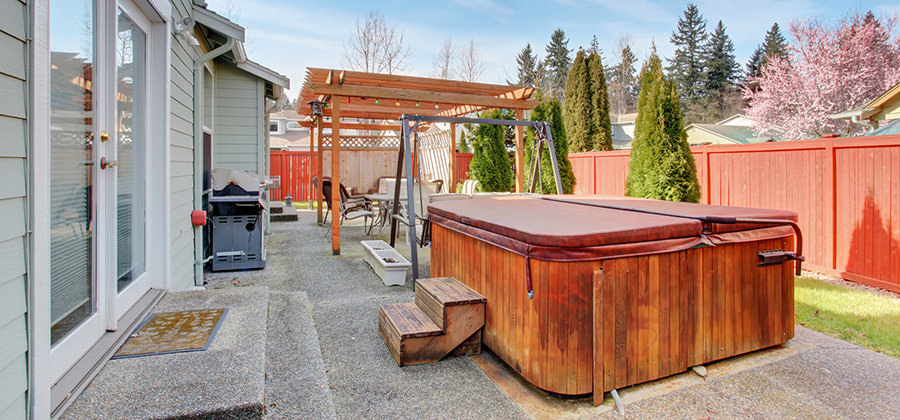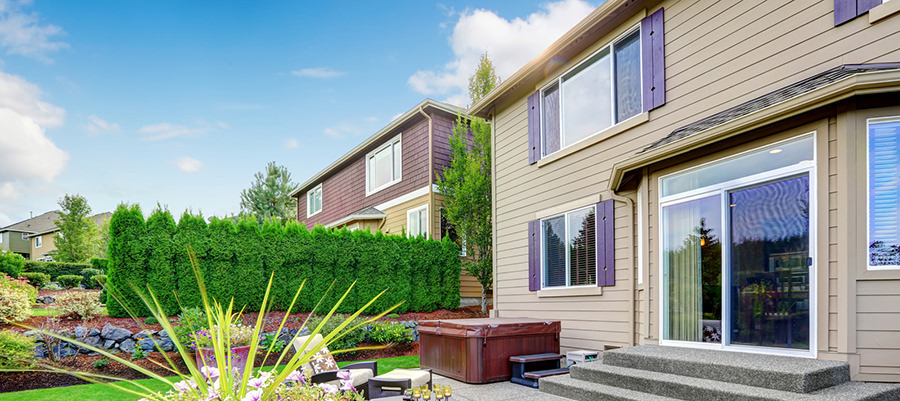
If you have decided to install a hot tub in your garden you will need to decide what sort of base your hot tub is going to stand on. Two of the most popular hot tub bases are pavers and concrete. But which one os best? Are there advantages or disadvantages to each and which sort of base might be best for your hot tub?
So, pavers v concrete for a hot tub base – which is best? Both pavers and concrete are a perfectly suitable base for a hot tub. A hot tub base has to be level and capable of withstanding the weight of the hot tub plus water and bathers. Both pavers and concrete are strong enough for the job.
In fact, many prospective hot tub owners don’t realise that in fact there are more options for hot tub bases than just concrete or pavers. As long as the surface that a hot tub sits on is strong and stable it can be made from many different materials including gravel, reinforced decking or even a commercially available spa pad.
What Makes A Suitable Base For A Hot Tub?
Before considering the type of base that’s suitable for your hot tub, you need to consider the weight of the tub – not only itself but with the bathers and water inside it too. An empty hot tub may be able to sit easily on your sun deck, but if you fill it up and then invite the family around for a soak in the bubbles, will it withstand the extra weight? This is why it’s so important to get the foundation right for your spa before you install it.
The most common option for a hot tub base is concrete, but that isn’t the only option. Although many people believe that concrete is the only suitable base for a hot tub, there are other choices as long as the tub isn’t placed directly on bare earth or grass. For example, stone pavers are another great choice as are reinforced wood decks or spa pads made from heavy-duty plastic. Even a gravel bed is a suitable option since it con forms to the base of the tub to hold it firmly in position.
Essentially, so long as the base where your hot tub will be placed is level, solid and uniform, and is capable of supporting the weight not only of the hot tub but of the water and bathers that it contains, you shouldn’t experience any issues with the installation process.

Nevertheless, choosing a base for your hot tub isn’t just about suitability, it’s about aesthetics, convenience and cost too. If you already have paving slabs in your garden, these may well be suitable for your spa to be placed on as long as they can take the weight. This will save you money in the long run.
If your garden is entirely grassed, though, you’ll need to create a base. Spa pads are cheap, but aren’t as robust as concrete. However, concrete takes longer to dry and so will delay your installation by several days. Meanwhile, paving slabs are heavy and need to be correctly placed in order to make a suitable base.
All of these considerations need to be kept in mind when you’re choosing the best base for your needs. But, first of all, how do you choose the right location for your spa?
Where is the Best Location for a Hot Tub?
A hot tub can be located virtually anywhere in your garden. While some people like their hot tub to be hidden from sight in a secluded corner, others want it to be a major focal point in their space. Therefore, there isn’t a single answer to the question of how to choose the best location for a hot tub. As long as you’ve chosen a suitable base on which to place your spa, you can put it on a patio, deck or paving stones. Some people even put a gazebo over their tub so they can have an attractive spot in which to relax and bathe.
The ideal spot in which to site your hot tub is down to your personal preference, but it also depends on the landscape layout and design of your outdoor area. You’ll need to not only consider aesthetics but also practicality when siting your hot tub. For a start, you’ll need to consider delivery access. You’re your hot tub is delivered to your property it will need moving into its permanent site.
This means that the path to your chosen spot must be wide and clear enough to make transportation of the tub from the delivery point to its final destination easy. The dimensions of your chosen model should be clearly visible when you make your purchase so you will be able to check that the access route to your chosen spot will allow it to pass through with ease.
You’ll also need to consider structural support for your hot tub. As we’ve already discovered, a hot tub can be extremely heavy when filled up with water and people so you’ll need to ensure that you’ve chosen a spot with a suitable base or where a suitable base can be constructed. Waterproofing and drainage are two further considerations. Moisture can cause serious damage to a wooden deck, for example, and as the spa tub will need draining from time to time, you can expect some incidental overflow to occur on occasion.
It’s therefore best to ensure the spa is located close to an existing drain or in a spot where a drain can be placed if one needs to be installed. Also, you’ll need to remember that the drainage channel must direct water away from the equipment compartment of the spa to avoid damage. If your hot tub is going to be placed close to or on top of wood, make sure that the wood has first been protected with a coating of oil-based sealant before installing the spa. This will help to guard against rot and mildew which could cause major damage over time.
Other considerations when choosing the right location for your hot tub include ease of use and maintenance. The easier you can access your spa, the more you’ll make use of it. This means that convenience should be a major consideration when selecting a location for your tub. If your tub is right at the back of your garden, you may not want to use it as often as one that is right there on the patio within easy reach of your back door.

You should also bear the weather in mind. If you’re living in an area where the climate isn’t ideal – like the UK – you will need to think about when you’ll use your hot tub and how you can protect yourself from the weather on cold days. Placing your tub inside a gazebo could be ideal, giving you protection from the elements and an attractive and private place to soak in the bubbly water.
Maintenance access is also key when siting your hot tub. You will need to routinely maintain your tub and sometimes inevitably, repairs will need to be carried out. If it’s hard to reach the important parts of your hot tub, you may not be encouraged to maintain it as often as you should. Also, if internal components need repairing or replacing, engineers need to be able to reach them without any difficulty. When you choose a location for your hot tub, ensure that you can fully open the equipment access panel – moving heavy obstacles to repair a spa can be a major pain.
Finally, privacy and comfort are considerations when choosing the right location for your hot tub. Even if your tub is designed to be a focal point in your garden you probably don’t want your neighbours watching you from their windows! Therefore, installing a privacy screen, gazebo or some plants in tubs around your spa will not only make the area more attractive but it will also make you feel more secluded and private when relaxing in the tub at the end of a long day.
A hot tub is a major investment and you want to make the most of it and protect it for many years to come. With this in mind, choosing the right spot and the right base for your spa is imperative. If you make the wrong choices in the beginning, you can find that your spa isn’t as appealing as you hoped that it would be and, in the worst case scenario, it may not last for as long as it should due to a poor quality base that causes damage to the shell of the tub.
How Do I Make A Hot Tub Base Out Of Concrete?
Concrete has long been the base of choice for hot tubs thanks to its robustness and durability. Hot tubs, when filled up with water and bathers, are extremely heavy and therefore having a level and strong surface for them to sit on couldn’t be more important. An uneven or unsound surface could not only damage your tub but could even invalidate its warranty and this is clearly something that you would want to avoid if you’ve just invested a lot of money in your purchase.
While concrete is an excellent base for a hot tub, it’s quite costly to install at your property. Nevertheless, it does bring the advantage of minimal long-term maintenance so you’ll need to weigh up the pros and cons of this option. You need a 4” concrete slab to form a suitable base for a hot tub that is capable of withstanding weights of a minimum of 115lbs per square foot. If your hot tub is on the larger side, this is even more important, and you need to give the concrete time to fully cure before installing the tub on top of it.
The process of curing involves a chemical reaction which takes place between water and cement. The process binds the gravel and sand together to form concrete. If you have poured a fresh concrete base for your hot tub you’re going to need to wait for almost a month for it to cure completely. During this time, you also need to ensure that moisture remains in the concrete or the finished result will be weakened with cracking and stresses.
In the short term, then, concrete bases require a lot more maintenance since you’ll need to control both the temperature and moisture content of your freshly poured concrete, hosing it down regularly with water between 5 and 10 times a day for the first 7 days if the weather is warm.
Alternatively, you can use a cover made from 4mm thick polyethylene sheeting to trap moisture in the concrete and slow down the evaporation process. Simply wet the fresh concrete thoroughly before covering it.
What Kind Of Paving Stones Are Suitable As A Hot Tub Base?
There are many different types of paving stones that are suitable for use as a hot tub base including those made from cobblestone, concrete, rubber, flagstone or brick. Bear in mind, though, that raised pavers with ridges or bumps can be problematic since they put extra stress on the shell of your hot tub. You should, therefore, only choose smooth, interlocking pavers to create a fully flat surface on which to place your spa.
Pavers are a suitable choice of base because they are high-density and offer more support when compared with wood or even concrete slabs. Their low rate of absorption also makes them resistant to other common issues that occur with poured concrete bases such as efflorescence.
Another advantage of pavers is that the offer easier access to buried plumbing or electrical lines should a problem arise. They can simply be removed then replaced once the issue is rectified.

Also, pavers bring more design possibilities since they’re available in a choice of sizes, textures, shapes and colours.
They can also be put down and the tub can be placed on top of them straight away. There’s no need to wait for 28 days for cement to cure. You can simply build your base and install the tub in a single day.
If you’re choosing between different paver options, concrete patio pavers could be the perfect choice thanks to their good looks, durability and affordable price tag. They come in many colours, sizes, styles and patterns. Alternatively, opt for permeable pavers that are an eco-friendly choice. Since they’re durable they can withstand water and heat well, and they also allow water to pass through which eliminates any issues surrounding pooling of water around the tub. They’re also non-slip so bathers can be safe around the water.
Is Wooden Decking A Suitable Base For A Hot Tub?
Although many people believe that you can’t fit a hot tub onto wooden decking, in fact it’s perfectly possible to do this as long as you take the right precautions and prepare the space properly. It’s essential, though, that if you’re considering using a wood deck as a base for your hot tub you bear in mind the weight not only of the tub but of its occupants and the water that it will hold. A standard surface-level deck will probably be capable of taking the weight of your fully-loaded spa tub. However, if you have a raised deck, that may not be the case.
The higher from the ground your decking is, the more chance there is that you’ll need to reinforce it to cope with the additional weight. You may need to add extra wood or even concrete underneath the deck to make sure that it can cope otherwise you could be putting yourself at risk every time you get into the tub.
You also need to bear a few other things in mind when you install a hot tub on decking. You’ll need to ensure there is sufficient space around the tub to allow the cover to be removed and bathers to enter and exit the tub easily. You’ll also need to ensure that the deck has been correctly finished and sanded – you don’t want to get splinters in your feet every time you go to use your hot tub!
What Are My Other Options When It Comes To Finding A Suitable Spa Base?
Although concrete, pavers and decking are the three primary options that most spa-owners go for when choosing a base for their tub, there are a few other bases that you can pick from.
Crushed stone is one option that you may go for. Inexpensive and simple, crushed stone is an easier way of preparing the ground for your new spa. Although not as solid or attractive as pavers or even concrete, it works well if executed correctly.

If you wish to install a crushed stone base, you’ll need to first dig up the top soil and grass, digging down by around 3 to 4 inches. Make sure the ground is as level as possible. Once this is complete, run two 4×4” stringers so that they’re entirely level over the area at a space of around 4 feet apart. This ensures you have a basis to work from to keep the surface level. Fill the space with 4 inches deep of crushed stone, making the area around 4 to 6 inches larger than the tub itself. Pack down the stone and level it well before setting the tub onto it.
Another option for your spa base is a prefabricated pad. Made from plastic, these bases are typically sold in kits that you purchase in the correct size for your tub. Although some people believe that no preparation is required for a spa pad, in fact this isn’t true. You’ll need to prepare the area in just the same way as if you were using crushed stone.
Although some people think it’s possible to use cinder blocks as a base for a spa, they aren’t suitable for use as the only base. They’re ideal for extra support, but the surface you use as a base for your spa must be level, uniform and flat, capable of holding the tub when it is full. Even if the ground was completely level under cinder blocks, the surface wouldn’t be even enough to prevent damage and stress to the tub’s shell. Also, cinder blocks are typically hollow in the centre, so they would probably not offer sufficient support for the weight of your fully-loaded spa.
Related Questions
How much does a hot tub weigh? When you’re considering what type of base to choose for your hot tub, you need to keep its weight in mind. Although some people only think about the weight of the tub when it is empty, this is a big mistake. An empty hot tub will weigh just 600 – 800lbs.
However, once water is added, its weight increases dramatically. In fact, a tub that is full of water can weigh as much as 2500 – 4300 lbs. Then, of course, you need to bear in mind that people will be using the tub too and their weight will be added to that of the tub and the water inside it. A large tub can hold seven or eight bathers, and combined, their weight can be significant.
Once people are added to the tub, it isn’t impossible to see the total weight of your hot tub jump from around 3000 lbs up to around 6000 pounds. A hot tub’s weight will entirely depend on its capacity – not just is water capacity but its bather capacity too. If your spa is very small and designed for just two or three bathers, you can expect it to weigh around 600 lbs when empty.
While this allows you to move a small tub around relatively easily when empty, bear in mind that even this small and relatively light tub will weigh as much as 3000 lbs when full of water. Large tubs that hold around 6 people at any one time weigh around 800 lbs when empty and even larger models that hold up to 8 people can weigh as much as 1000 lbs even before you fill them with water.
Once they’re full of water, you can expect them to weigh as much as 6000 pounds. This is a considerable weight and must be borne in mind when choosing a suitable base. If you fail to choose a base that is capable of withstanding this weight you’ll find that damage can occur to the tub itself and anyone using it could be put at risk of injury should the tub fall through the decking that it has been placed on during use.
How do I move a hot tub? When you buy your hot tub, the chances are that you’ll want to keep it in its chosen spot for a long time. However, what happens when you move home? Can you take your hot tub with you? Or what about if you want to re-landscape your garden and have chosen a different spot for the tub? Can you move it? And if so, how? If your hot tub isn’t too heavy or large, you may be able to move it by yourself. This may be possible if yours weighs under 600 lbs when empty (obviously you should drain your spa before trying to move it!)
However, the largest hot tubs can weigh more than that and you could injure yourself if you try to tackle the job alone. Usually, it’s best to enlist the help of a family member or friend when moving a hot tub, even a smaller one. For a large tub, you should have two people on each side. To move a hot tub, turn it onto its side so that you can get the best possible grip. If you’re going to be transporting a hot tub on a trailer, you’ll need to make sure that you’ve protected the metal surface of the trailer with some plywood to stop the tub’s shell from being scratched.
Be aware that although you can carry a hot tub on its side, you should never transport it any distance that way. Transporting a hot tub on its side can damage its walls and even damage its overall structure.
Also, it won’t be able to be properly secured and with its uneven weight distribution in this position it could easily topple over causing a lot of damage in transit. When you place the hot tub on a trailer or in a vehicle for transportation, you can carry it on its side, but when you place it down for transport you should lay it down on its base. This makes securing it easier and will stop any possibility of additional damage.

